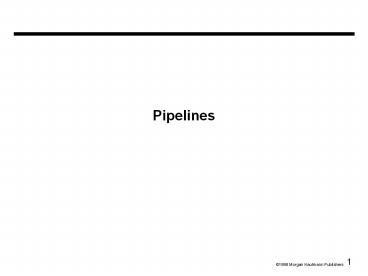Pipelines PowerPoint PPT Presentation
Title: Pipelines
1
Pipelines
2
Pipelining
- Improve perfomance by increasing instruction
throughput - Ideal speedup is number of stages in
the pipeline. Do we achieve this?
3
Pipelining
- an implementation technique whereby multiple
instructions are overlapped in execution (A-2). - Takes advantage of parallelism that exists among
the actions needed to execute an instruction. - In our discussion we have discussed 5 key actions
necessary to execute an instruction - We see that the MIPS hardware is organized around
these 5 - Performance increase (ideal)
- Time per instruction on un-pipelined
machine number of
pipeline stages - The net effect is to reduce the number of clock
cycles per instruction.
4
Pipelining
- Processor Cycle the time it takes to move an
instruction one step down the pipeline. - All stages must be complete and ready to proceed
at the same time. - Designer must balance the length of each pipeline
state, since they all must be ready to proceed at
the same time, the processor cycle time is that
time sufficient to handle the longest pipeline
state execution.
5
Pipelining - What makes it easy for MIPS
- All instructions are the same length and simple
in format - At completion of fetch, no decisions to be made
which would significantly vary the time length of
the pipeline stage. - The simple formats with the fields always in the
same place simplifies instruction decode and
register fetch. Fixed-field decoding. - Memory operands appear only in loads and stores
- The ALU computes addresses for memory operands
- It does not also have to be reused since no
arithmetic operations are performed on data in a
load or store, and no address computation is
performed for an arithmentic operation.
6
Pipelining
- What makes it hard?
- structural hazards suppose we had only one
memory - control hazards need to worry about branch
instructions - data hazards an instruction depends on a
previous instruction - Well build a simple pipeline and look at these
issues - Well talk about modern processors and what
really makes it hard - exception handling
- trying to improve performance with out-of-order
execution, etc.
7
Basic Idea
- What do we need to add to actually split the
datapath into stages?
8
Pipelined Datapath
- Can you find a problem even if
there are no dependencies? What instructions
can we execute to manifest the problem?
9
Corrected Datapath
Do we need a mux here?
10
Graphically Representing Pipelines
- Can help with answering questions like
- how many cycles does it take to execute this
code? - what is the ALU doing during cycle 4?
- use this representation to help understand
datapaths
11
Pipeline Control
12
Pipeline control
- We have 5 stages. What needs to be controlled in
each stage? - Instruction Fetch and PC Increment
- Instruction Decode / Register Fetch
- Execution
- Memory Stage
- Write Back
- How would control be handled in an automobile
plant? - a fancy control center telling everyone what to
do? - should we use a finite state machine?
13
Pipeline Control
- Pass control signals along just like the data
14
Datapath with Control
15
Dependencies
- Problem with starting next instruction before
first is finished - dependencies that go backward in time are data
hazards
16
Software Solution
- Have compiler guarantee no hazards
- Where do we insert the nops ? sub 2, 1,
3 and 12, 2, 5 or 13, 6, 2 add 14,
2, 2 sw 15, 100(2) - Problem this really slows us down!
17
Forwarding
- Use temporary results, dont wait for them to be
written - register file forwarding to handle read/write to
same register - ALU forwarding
18
Forwarding
19
Can't always forward
- Load word can still cause a hazard
- an instruction tries to read a register following
a load instruction that writes to the same
register. - Thus, we need a hazard detection unit to stall
the load instruction
20
Stalling
- We can stall the pipeline by keeping an
instruction in the same stage
21
Hazard Detection Unit
- Stall by letting an instruction that wont write
anything go forward
22
Branch Hazards
- When we decide to branch, other instructions are
in the pipeline! - We are predicting branch not taken
- need to add hardware for flushing instructions if
we are wrong
23
Flushing Instructions
24
Improving Performance
- Try and avoid stalls! E.g., reorder these
instructions - lw t0, 0(t1)
- lw t2, 4(t1)
- sw t2, 0(t1)
- sw t0, 4(t1)
- Add a branch delay slot
- the next instruction after a branch is always
executed - rely on compiler to fill the slot with
something useful - Superscalar start more than one instruction in
the same cycle
25
Dynamic Scheduling
- The hardware performs the scheduling
- hardware tries to find instructions to execute
- out of order execution is possible
- speculative execution and dynamic branch
prediction - All modern processors are very complicated
- DEC Alpha 21264 9 stage pipeline, 6 instruction
issue - PowerPC and Pentium branch history table
- Compiler technology important
- This class has given you the background you need
to learn more

